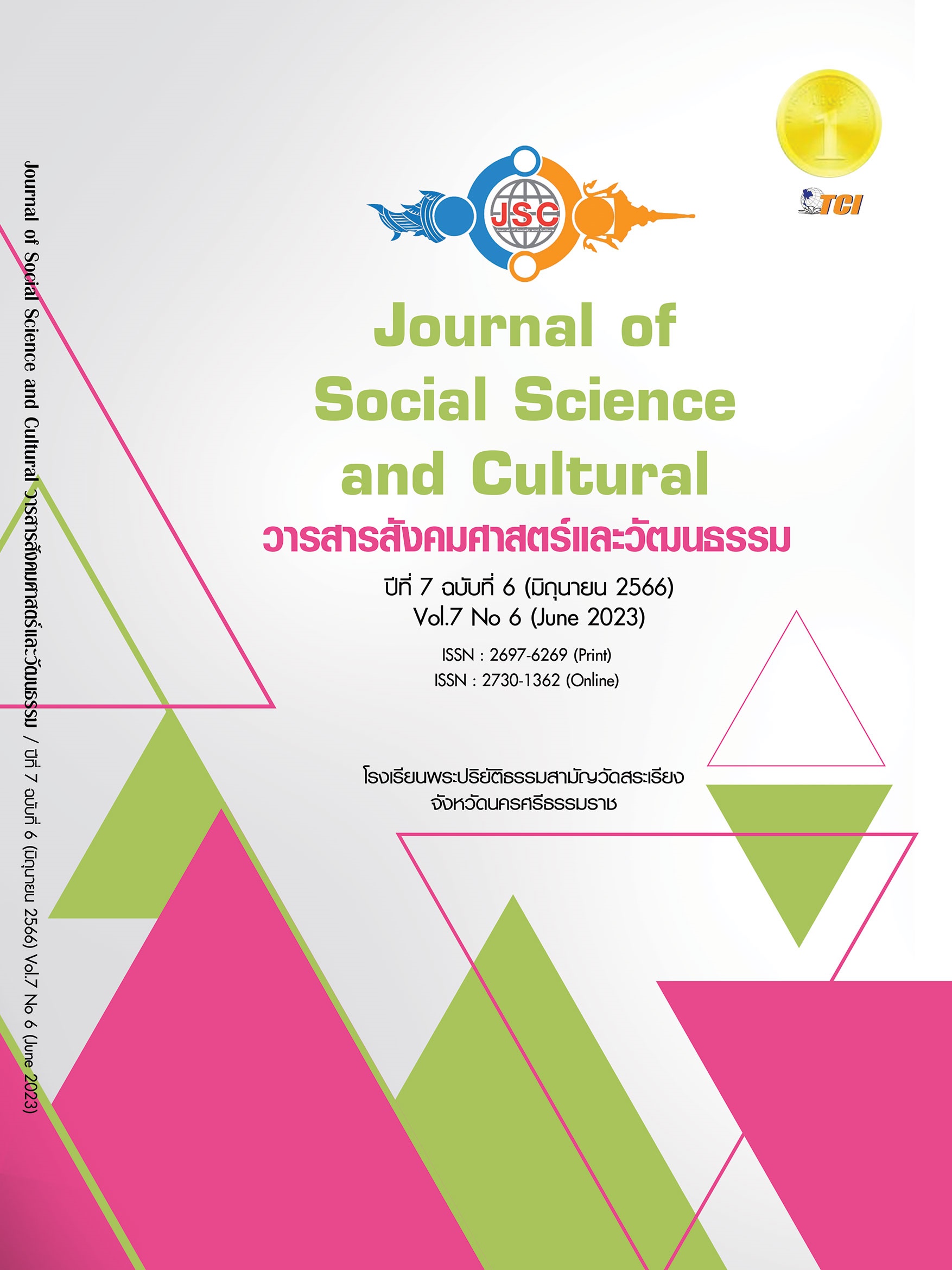COMMUNICATION FOR THE ELECTION CAMPAIGN IN THE CHIEF EXECUTIVE OF PROVINCIAL ADMINISTRATIVE ORGANIZATION BY PROGRESSING SAMUTPRAKARN GROUP
Main Article Content
Abstract
The purposes of this research were to study 1) concepts and policies 2) communication management. 3) Communication Strategies and 4) Communication Development Guidelines It is a qualitative research with in-depth interviews. Twenty-four key informants were chosen by a electoral campaign purposive method: 1 group leader, 3 founding representatives, 1 manager, 5 executive leaders, 10 operational leaders, 1 consultant, and academics with knowledge of the campaign. expertise of 3 people. Research tools were structured in-depth interviews. Analyze data by forming conclusions. The results of the research revealed that 1) The concept and communication policy was to communicate to encourage voters to have common behavior. 2) communication management, namely establishing an office to drive campaigning; Use technology systems to manage the sound base. The content is concise, understandable, easy to remember, distributed repeatedly through the media of billboards, campaign tickets, parades, voters, and social media using frequencies appropriate to the time. management, monitoring, evaluation 3) communication strategy by dividing the right to vote into 3 groups, namely the support group unsupported group and the undecided group Candidate Branding Strategies Emphasis on strong female leadership intend to solve the problem natural expression Use a voter as a close person. good communication skills Strategies for designing messages, slogans, and policies for developing and solving problems. persuasively using messages, speeches that are pleasing to the eye. 4) guidelines for communication development. Use video clips to visit the area. develop communication skills dispute the allegation and develop an online evaluation system.
Article Details
References
กชกร ขันธบุญ. (2565). คลิปวีดีโอกับการรณรงค์หาเสียงเลือกตั้งบนสื่อสังคมออนไลน์. วารสารพิกุล, 20(1), 381-398.
กรมส่งเสริมการปกครองท้องถิ่น. (2561). แผนพัฒนาจังหวัดสมุทรปราการ 4 ปี (พ.ศ.2561-พ.ศ.2565) โดยกลุ่มงานพัฒนายุทธศาสตร์และข้อมูลเพื่อการพัฒนาจังหวัด. ระบบข้อมูลกลางองค์กรปกครองส่วนท้องถิ่น. เรียกใช้เมื่อ 23 เมษายน 2566 จาก https://www.samutprakancity.go.th
กฤตาภรณ์ ทะราษี. (2564). การเข้าสู่ฐานอำนาจทางการเมืองของสตรีในองค์กรปกครองส่วนท้องถิ่นจังหวัดภาคะวันออกเฉียงเหนือ. วารสารสังคมศาสตร์และมานุษยวิทยาเชิงพุทธ, 6 (2), 426-440.
กาญจนา แก้วเทพ. (2554). สื่อเก่า สื่อใหม่ ใจเชื่อมร้อยโครงการเมธีวิจัยอาวุโส ฝ่ายวิชการ สำนักงานกองทุนสนับสนุนการวิจัย. กรุงเทพมหานคร: ห้างหุ้นส่วนจำกัดภาพพิมพ์.
กานต์ บุญศิริ. (2565). การหาเสียงเลือกตั้งผ่านสื่อสังคมออนไลน์ของผู้สมัครรับเลือกตั้ง นายกองค์การบริหารส่วนจังหวัดสงขลา พรรคประชาธิปัตย์. วารสารมนุษยสังคมสาร (มสส.), 20 (3), 165-187.
ทวีรัตน์ เลาหทัยชนก. (2565). การพัฒนาแกนนำทางการสื่อสารของทีมต้นกล้านครตรังในการหาเสียงเลือกตั้งนายกเทศมนตรีและสมาชิกสภาเทศบาลนครตรัง. วารสารสังคมศาสตร์และมานุษยวิทยาเชิงพุทธ, 7(11), 262-279.
นิรัตน์ เพชรรัตน์ และคณะ. (2564). กลยุทธ์การรณรงค์หาเสียง เลือกตั้งของนายกองค์การบริหารส่วนจังหวัด. วารสาร มจร การพัฒนาสังคม, 6(1), 153-160.
พระครูใบฎีกาวิชาญ ทรงราศี. (2565). ยุทธศาสตร์การสื่อสารของพรรคการเมืองไทยในยุคดิจิทัล. วารสารมหาจุฬาคชสาร, 13 (1), 47-58.
พัชรีภรณ์ ยุทธนาพงศ์กิตติ. (2563). การศึกษากลวิธีการโน้มน้าวใจจากข้อความบนป้ายโฆษณาหาเสียงเลือกตั้งมาชิกสภาผู้แทนราษฎร เขต 1 จังหวัดจันทบุรีพ.ศ. 2562. วารสารวิชาการมนุษยศาสตร์และสังคมศาสตร์รำไพพรรณี, 1(1), 61-75.
พันธกานต์ ทานนท์. (2563). กลยุทธ์การตลาดการเมืองไทยปี 2562 กรณีศึกษา : พรรคอนาคตใหม่. วารสารนิเทศศาสตร์และนวัตกรรม นิด้า. สถาบันบัณฑิตพัฒนบริหารศาสตร์, 7(2), 96-116.
ไพลิน ภู่จีนาพันธุ์. (2563). โครงการศึกษาการเลือกตั้งระดับท้องถิ่น ปี 2563: การเลือกตั้งสมาชิกสภาองค์การบริหารส่วนจังหวัดและนายกองค์การบริหารส่วนจังหวัดเชียงใหม่. ใน รายงานวิจัย. สถาบันพระปกเกล้า.
ภัทรพันธุ์ นิธิวรัตน์สกุล. (2566). อวัจนภาษา: สัญลักษณ์การเคลื่อนไหวทางการเมืองของเยาวชนไทย. Journal of Roi Kaensarn Academi, 8(3), 501-512.
วิทยาธร ท่อแก้ว และคณะ. (2563). ทฤษฎีการสื่อสารเพื่อการรณรงค์ทางการเมืองและสังคม. นนทบุรี: มหาวิทยาลัยสุโขทัยธรรมาธิราช.
สมยศ ปัญญามาก. (2561). พรรคการเมืองกับการหาเสียงเลือกตั้ง. วารสารวิชาการบริหารศาสตร์ มหาวิทยาลัยมหาจุฬาลงกรณราชวิทยาลัย วิทยาเขตพะเยา, 1(4), 81-96.
สุภาพ กริ่งรัมย์. (2555). กลวิธีการโน้มน้าวใจในการปราศรัยหาเสียงเลือกตั้งทั่วไป ปี พ.ศ. 2554 ของนางสาวยิ่งลักษณ์ ชินวัตรและนายอภิสิทธิ เวชชาชีวะ. วารสารภาษาและภาษาศาสตร์, 31(1), 20-43.
สุเมธ ตั้งประเสริฐ. (2565). กลยุทธ์และวิธีการสื่อสารของพรรคการเมืองไทยผ่านสื่อสังคมออนไลน์ ในการเลือกตั้งทั่วไป พ.ศ. 2562. วารสารรัฐศาสตร์ มหาวิทยาลัยราชภัฏสวนสุนันทา, 5(1), 25-38.
สุรพงษ์ โสธนะเสถียร. (2545). แนวคิดในการหาเสียงเลือกตั้ง. กรุงเทพมหานคร: ประสิทธิ์ภัณฑ์แอนด์พริ้นติ้ง.
อาทิยา สมโลก. (2563). กลยุทธ์การจูงใจและวาทกรรมของป้ายโฆษณาหาเสียงเลือกตั้งปี 2562ในจังหวัดปัตตานี. วารสารนิเทศศาสตรปริทัศน์, 24(2), 166-178.
Baumgartner, J. C. (2022). The management of political campaigns. A Research Agenda for : Political marketing.
Gramatyka, M. (2020). Project management and an election campaign–a case study. Innovation in: Organisational Management.
Harold D. Lasswell. (1966). The Structure and Function of Communication in Society, In Public Opinion and Communication. New York: Free Press.
Stephen A. Salmore and Barbara G. Salmore. (1989). Candidates, Parties, and Campaigns: Electoral Politics in America. United States: A division of Congressional Quarterly Inc.


